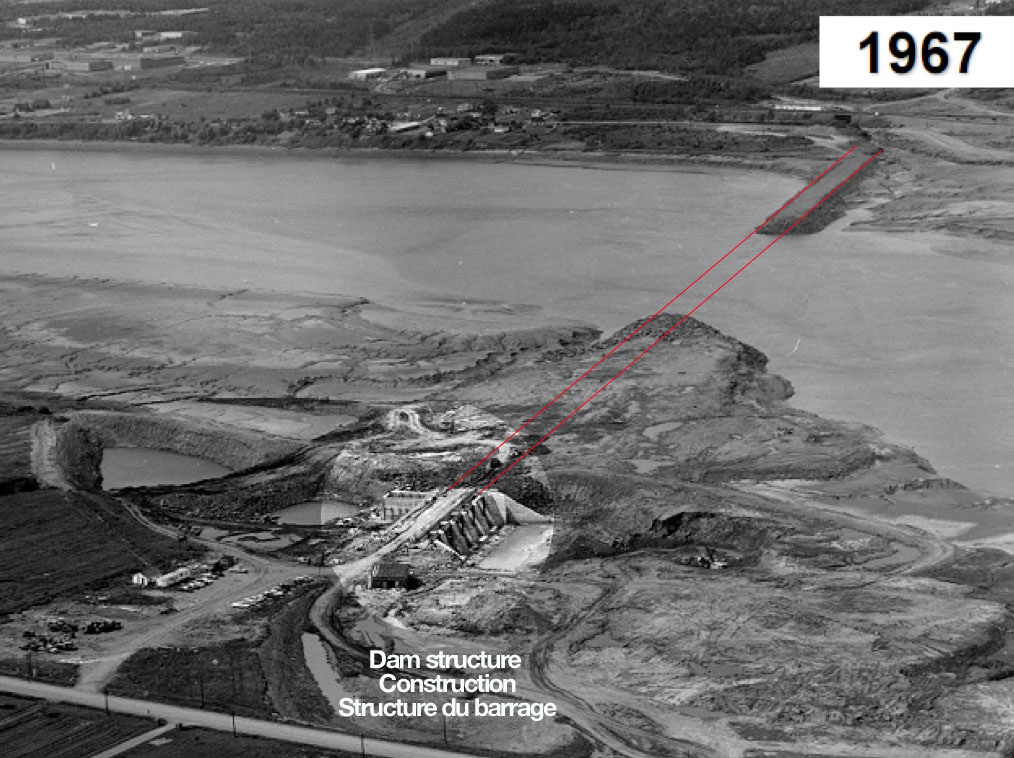CONSTRUCTION AND CONTROVERSY (1962-1999)

Proposed in 1962 by the federal Maritime Marshland Reclamation Agency as an option to rebuilding the dike system in the upper reaches of the Petitcodiac and as an alternative to providing a crossing between the communities of Moncton and Riverview, the Petitcodiac River Causeway was a controversial project from the onset.
Fisheries officers were the first to voice their concerns in the early-1960’s, followed by the then Town of Moncton Council, commercial fishermen, recreational fishermen and commercial navigation users.
In the early 1960s, such projects were not required to be subjected through rigorous environmental assessment reviews or public consultations. On the other hand, several land development investors and commercial construction interests (rock quarry to build the rock-fill dam) were heavily in favour of the project, set to benefit from the creation of the 21 km long headpond in the community.
The matter was ultimately decided behind closed doors in 1964, with the federal government offering a significant financial incentive to the province to build a $3 million causeway instead of a bridge. The comparative costs of building a bridge instead of a causeway to cross the Petitcodiac were never presented, but are estimated to have been equal or slightly cheaper ($2.5 million). Construction began in 1966 and the project was completed in 1968.
Although the causeway was equipped with a fishway, problems immediately arose in 1969 when thousands of fish were found dead and unable to cross freely due to poor fishway design and sedimentation build-up.
During the first three years following construction, over 10 million cubic metres (13 million cubic yards) of silt is estimated to have accumulated in the 4.8 km (3 mi) of the river downstream from the causeway. Several reports from 1969 to 1971 described its devastating impact on the river’s fisheries, and proposals for amendments to the causeway gates were released, but no action was taken. In 1976 and 1977, federal reports pointed out several problems related to the gates’ function due to erosion, winter ice jams, and “unsatisfactory fishway operation.”
It was not until 1978 that New Brunswick’s Department of Transportation commissioned a study of the problems. The final report recommended three alternatives for action: to continue operation “as-is”, to continue operation without the gates, or to eliminate gate leakage and amend the operation protocol.
The third alternative was chosen two years later, but did not substantially improve fish migration as expected. The provincial government decided to open the gates between 15 April and 7 July 1988, to allow fish to migrate upstream. This was repeated from 26 September to 31 October 1988, and in the spring of 1989 and 1990 during low tides. In 1991, the federal Department of Fisheries and Oceans recommended opening the gates from April to December each year. A provincial government committee report recommended an additional seven options for the modification of the causeway in May 1992, but the government did not act upon any of these options due to the low “cost-benefit” factor. More reports documented problems related to the passage of fish in the river until 1995, when the Department of Transportation agreed to open one gate from April to December, as suggested four years earlier. A project was then organized in December 1996 to begin a trial for the systematic opening of the gates during the year, but conditions could not be physically met, and the project was ultimately terminated on 1 June 1999.
LAUNCH OF PETITCODIAC RIVERKEEPER AND FIGHT FOR THE PETITCODIAC RIVER’S RESTORATION (1999 – 2010)
Petitcodiac Riverkeeper was created in 1999 with the mandate to set out to reverse the tremendous ecological, economic and social devastation brought about to the region as a result of the Petitcodiac causeway. The Riverkeepers implemented a series of groundbreaking actions in environmental communications and environmental law enforcement. Ultimately, these efforts prevailed, leading to the opening of the gates of the Petitcodiac causeway in April 2010, the end of Canada’s longest environmental battle and the commencement of North America’s largest river restoration project. Read more.









